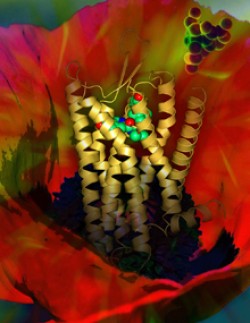Up Close With Opioid Receptors
Up Close With Opioid Receptors
Researchers have taken the closest-yet look at the structures of opioid receptors, which play key roles in pain relief and addiction. The findings might aid development of safer painkillers and addiction-fighting medications.

Structure of the κ-opioid receptor bound to the experimental drug JDTic is shown resting in a poppy flower, the source of opium. Image by Yekaterina Kadyshevskaya, PSI:Biology GPCR Network, Scripps Research Institute.
Opioid drugs—including codeine, morphine and brand name medications like Vicodin and Oxycontin—are widely prescribed for treating acute and chronic pain. But long-term opioid use carries a risk of addiction and tolerance. These drugs act by binding to receptors found on the surfaces of certain cells, mostly in the brain. There are 4 major types of opioid receptors, and many opioids bind to several different receptors, which may explain some of their unwanted side effects. By learning more about how opioid drugs interact with these receptors, scientists hope to be able to fine-tune their effects.
Two research teams independently tackled the challenge of uncovering atomic-scale details of different opioid receptors. The groups were headed by Dr. Raymond Stevens of the Scripps Research Institute and Dr. Brian Kobilka of Stanford University. Both studies were funded in part by NIH’s National Institute on Drug Abuse (NIDA) and other NIH components. The Scripps group also received significant support from NIH’s National Institute of General Medical Sciences (NIGMS).
Opioid receptors are part of a large family of proteins called G-protein coupled receptors (GPCRs), which are notoriously awkward to study in 3-D detail. Their large, floppy and unwieldy structures make them difficult to prepare for X-ray crystallography, which can detect atomic features but requires uniform crystals of the proteins. In 2007, innovations by Stevens, Kobilka and their colleagues overcame technical challenges and allowed them to solve the first X-ray crystal structure of a human GPCR (seestory). These techniques proved crucial to their new efforts, which were described in the March 21, 2012, advance online edition of Nature.
Stevens and colleagues solved the structure of the human κ-opioid receptor. Drugs that act on this receptor could be developed as potential therapies for depression, anxiety and addiction. To help stabilize the structure, the researchers bound the receptor to a tight-fitting experimental drug called JDTic, which has been shown to reduce relapse to cocaine seeking in animal models. By mapping all the points of contact between the receptor and drug, the researchers revealed how the 2 fit together so tightly. They also found that the receptor has a broad binding cavity with many potential anchoring points for incoming molecules.
Kobilka and colleagues studied the structure of the mouse µ-opioid receptor bound to a small morphine-like molecule. This receptor is the primary target for the most effective opioid analgesics, such as morphine and codeine, as well as opioid drugs of abuse such as heroin. The researchers found that this receptor also has a large binding pocket, with the small molecule bound deeply within.
With the structural details of these receptors now in hand, scientists may be better able to develop more highly targeted medications. “Drug abuse and addiction remain devastating public health challenges in the United States,” says NIDA Director Dr. Nora D. Volkow. “This research could aid in the development of effective medications for the treatment of drug addiction, particularly to stimulants like cocaine, for which there are no medications currently available.”
###
* The above story is reprinted from materials provided by National Institutes of Health (NIH)
** The National Institutes of Health (NIH) , a part of the U.S. Department of Health and Human Services, is the nation’s medical research agency—making important discoveries that improve health and save lives. The National Institutes of Health is made up of 27 different components called Institutes and Centers. Each has its own specific research agenda. All but three of these components receive their funding directly from Congress, and administrate their own budgets.




















